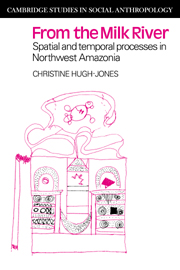Book contents
- Frontmatter
- Contents
- List of figures, tables and maps
- List of myths
- Preface
- Acknowledgements
- Orthography
- 1 Introduction
- 2 Social structure
- 3 The set of specialist roles
- 4 Kinship and marriage
- 5 The life-cycle
- 6 Production and consumption
- 7 Concepts of space–time
- 8 Conclusion
- Appendix 1 Named groups
- Appendix 2 Kinship terminology
- Works cited
- Index
- CAMBRIDGE STUDIES IN SOCIAL ANTHROPOLOGY
7 - Concepts of space–time
Published online by Cambridge University Press: 07 October 2009
- Frontmatter
- Contents
- List of figures, tables and maps
- List of myths
- Preface
- Acknowledgements
- Orthography
- 1 Introduction
- 2 Social structure
- 3 The set of specialist roles
- 4 Kinship and marriage
- 5 The life-cycle
- 6 Production and consumption
- 7 Concepts of space–time
- 8 Conclusion
- Appendix 1 Named groups
- Appendix 2 Kinship terminology
- Works cited
- Index
- CAMBRIDGE STUDIES IN SOCIAL ANTHROPOLOGY
Summary
Introduction
The source of the contemporary natural and social order is the ancestral past known through myth. However, it should be clear from the material so far discussed that the ancestral past is also an alternative aspect of the present which can be contacted through shamanism and ritual. In this chapter, the universe is treated as a conceptual construction which contains the activity and power associated With ancestral creation. In order to contact this alternative reality, people must transpose the system of the universe with its creative processes onto the concrete systems which they are able to control, or at least change, through practical action. To do this, they construct their houses to represent the universe. They also conceive of their bodies, their sexual reproductive systems, their natural environment known through direct experience and the structure of their patrilineal groups in such a way that these too correspond to the structure of the universe. Thus, the concrete world is derived from the ‘imaginary’ ancestral world, but it also provides the way to it. Countless examples of the transposability of different systems have already been given; instead of repeating them all here, this final chapter is focused on the more fundamental concepts of space–time upon which such transposition is founded.
- Type
- Chapter
- Information
- Publisher: Cambridge University PressPrint publication year: 1980

